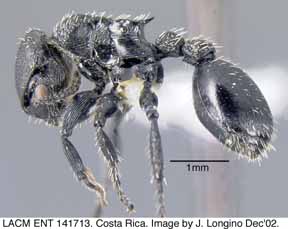

Formicidae, Hymenoptera, Insecta, Arthropoda, Animalia
|
|
|
Image catalogue, worker (click here).
Image catalogue, worker, sem (click here).
Range
Costa Rica, Mexico, Panama.
Description of worker
Worker measurements (n=1, Costa Rica): HW 1.537, HL 1.455, SL 0.800, EL 0.332, MeL 1.716, MeW 1.119, PrW 0.741, PrL 0.483, PrS 0.218, PrT 0.702, MTL 1.034, PtL 0.492, PtW 0.436, PpW 0.593, PtH 0.422, AL 1.746, AW 1.419, ASW 0.031.
Differing from P. impressus in the following respects: clypeus somewhat differentiated from face, upper margin slightly impressed, interantennal region slightly protruding, forming a stronger bend than in P. impressus; mesonotal teeth small, squared-off posteriorly, well before propodeal suture; propodeal suture shallow, mesonotum and dorsal face of propodeum in same plane; on some workers dorsal striae do not attain anterior pronotal border, being replaced by coarse piligerous foveae; posterior face of forefemur longitudinally rugose throughout; setae similar to P. impressus in form and distribution, but less dense, particularly on first gastral tergite; setae on disc of first gastral tergite sparse, widely spaced, not overlapping.
Differing from P. subpilosus in the relatively shorter petiole, and from P. tortuguero in the absence of erect setae on the frons. Also, unlike both P. subpilosus and P. tortuguero, the striae on the first gastral tergite extend to the posterior margin.
Description of queen:
Queen measurements (n=1, Costa Rica, barcode: INBIOCRI001282946): HW 1.400, HL 1.342, SL 0.767, EL 0.396, MeL 1.782, MeW 1.102, MTL 0.989, MFL 0.993, MFW 0.351, PtL 0.513, PtW 0.412, PpW 0.562, PtH 0.419, AL 1.628, AW 1.376, ASW 0.030.
Similar to worker in most respects; face uniformly, sparsely foveate, foveae larger than on P. impressus, interspaces subequal to fovea diameter, interspaces subopaque, with microareolate sculpture (interspaces somewhat shinier on P. impressus); interspersed rugae very weak to absent (in contrast to the workers, which have a mixture of foveae and abundant shallow rugae); pronotum foveate laterally, each fovea with stiff, flattened seta; fovea density lower on medial pronotum, but foveae still large (in contrast to impressus, which has medial foveae absent or reduced to small puncta); mesoscutum, axillae, and scutellum with a mixture of elongate foveae and longitudinal striae; relatively sparse setae on mesoscutum, axillae, and scutellum; dorsal face of propodeum longitudinally striate.
The above description is based on 5 queens from Costa Rica. 1 queen from Los Tuxtlas, Mexico differs in being much more worker-like. The face sculpture is like the worker (with a greater abundance of rugae and a reduced development of discrete foveae), and the pronotum is uniformly closely foveate, with no decrease in fovea density medially.
Comments:
One Mexican worker (Veracruz Prov., S. Lucrecia, April 1923 (Mann) [USNM]), which Kempf (1951) identified as P. paleatus, is P. scabriusculus.
Natural History
Procryptocerus paleatus is restricted to primary rainforest, where workers have been collected on low vegetation and in treefalls. At Corcovado National Park, workers were very rarely encountered on low vegetation, yet occurred in nearly every treefall or canopy sample. Procryptocerus paleatus is common in canopy fogging samples from La Selva Biological Station.
Types and Synonymy
Procryptocerus paleatus Emery, 1896:97. Holotype worker: Costa Rica, Atirro, near Jimenez [MCSN].
Procryptocerus paleatus (part, see under P. tortuguero): Kempf, 1951:53-55.
Page author:
John T. Longino, The Evergreen State College, Olympia WA 98505 USA. longinoj@evergreen.edu
Date of this version: 6 December 2002.